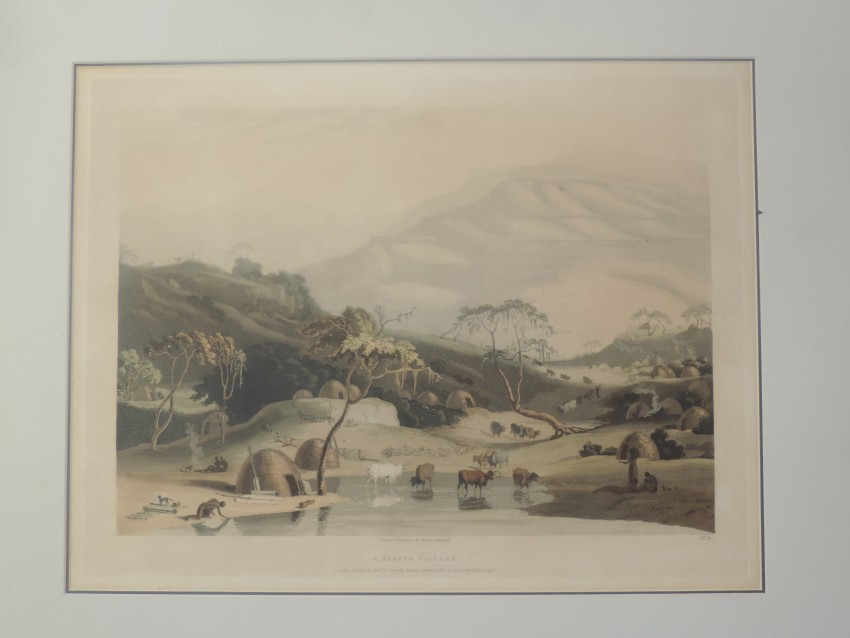35
Rand McNally South Africa This full-colour map of South(ern) Africa was printed by chromolithography
This full-colour map of South(ern) Africa was printed by chromolithography and included in Rand McNally’ 1895 Atlas of the World. It provides an accurate, cartographic snapshot of Southern Africa shortly before the second Anglo Boer War (1899 – 1901).
The colours of the map also neatly reveal the southern 'Scramble for Africa. In order to frustrate the intentions of the Boers, Tongaland in the north-east of South Africa, was placed under British ‘protection’ in 1895, incorporated into Zululand in 1897 after the infamous Anglo-Zululand War and, within days, it was incorporated into Natal which was under control of the British Cape Colony. Neighbourig Gazaland ('State of East Africa' on the map) was under Portuguese control, while Bechuanaland (now Botswana) became a British Protectorate. German Great Namaqualand later became South West Africa, now Namibia – the tiny enclave of British Walvis Bay can be seen on the coast.
After the Anglo Boer War the Orange Free State and Transvaal Republic came under British control and, in 1910, together with the Cape Colony and Natal, formed the four provinces of the British controlled Union (now the Republic) of South Africa.
The railway network, construction of which started in earnest in 1875, is well depicted; the railways played an important role in the location of conflict during the war. In 1899, a young Winston Churchill escaped from imprisonment in Pretoria and travelled by the train, on the recently inaugurated line to the coast, to reach safety in Lorenzo Marques (Maputo today) in Mozambique (then Gaza Land).
The original end destination of the Cape railway line, from Cape Town, Port Elizabeth and East London, was the diamond fields in Hope Town (diamonds discovered in 1866) on the Orange River, but discovery of diamonds in Kimberley (1871) and gold on the Witwatersrand (1886) diverted the tracks through the Boer controlled Ornage Free State to Johannesburg in the Transvaal Republic, also controlled by the Boers.
The is an attractive map of South Africa a few years before the Second Anglo Boer War.
Rand McNally
Chicago
1895
Fine
Visit AntiquarianAuctions.com for further details and to bid
This full-colour map of South(ern) Africa was printed by chromolithography and included in Rand McNally’ 1895 Atlas of the World. It provides an accurate, cartographic snapshot of Southern Africa shortly before the second Anglo Boer War (1899 – 1901).
The colours of the map also neatly reveal the southern 'Scramble for Africa. In order to frustrate the intentions of the Boers, Tongaland in the north-east of South Africa, was placed under British ‘protection’ in 1895, incorporated into Zululand in 1897 after the infamous Anglo-Zululand War and, within days, it was incorporated into Natal which was under control of the British Cape Colony. Neighbourig Gazaland ('State of East Africa' on the map) was under Portuguese control, while Bechuanaland (now Botswana) became a British Protectorate. German Great Namaqualand later became South West Africa, now Namibia – the tiny enclave of British Walvis Bay can be seen on the coast.
After the Anglo Boer War the Orange Free State and Transvaal Republic came under British control and, in 1910, together with the Cape Colony and Natal, formed the four provinces of the British controlled Union (now the Republic) of South Africa.
The railway network, construction of which started in earnest in 1875, is well depicted; the railways played an important role in the location of conflict during the war. In 1899, a young Winston Churchill escaped from imprisonment in Pretoria and travelled by the train, on the recently inaugurated line to the coast, to reach safety in Lorenzo Marques (Maputo today) in Mozambique (then Gaza Land).
The original end destination of the Cape railway line, from Cape Town, Port Elizabeth and East London, was the diamond fields in Hope Town (diamonds discovered in 1866) on the Orange River, but discovery of diamonds in Kimberley (1871) and gold on the Witwatersrand (1886) diverted the tracks through the Boer controlled Ornage Free State to Johannesburg in the Transvaal Republic, also controlled by the Boers.
The is an attractive map of South Africa a few years before the Second Anglo Boer War.
Rand McNally
Chicago
1895
Fine
Visit AntiquarianAuctions.com for further details and to bid
Online Rare Books, Maps & Prints and Photography Auction
Sale Date(s)
Venue Address
General delivery information available from the auctioneer
Registration on AntiquarianAuctions.com is free of charge.
As a successful bidder you will receive an invoice from the seller after the auction. The seller will only invoice the final selling price. We do not charge a buyer’s premium and no VAT applies.
The buyer pays for shipping and insurance costs which can be requested from the seller before the end of the sale.
Important Information
This is an online only auction. Please visit AntiquarianAuctions.com for further information about a lot and to bid
Terms & Conditions
There is no buyer’s premium charged on AntiquarianAuctions.com
AntiquarianAuctions.com is an online rare book auction website. All lots are listed by recognised booksellers who have been vetted before being accepted to sell on the site. This allows buyers to bid with confidence and ensures that lots are accurately described.
Bidding will begin on 26 August at 5.30 pm (UK time) and ends on 1 September at 5.30 pm (UK time). Please follow the countdown on AntiquarianAuctions.com.
Please visit AntiquarianAuctions.com for further information about a lot and to bid


